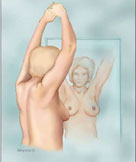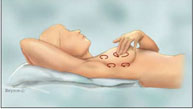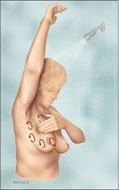Breast self-examination is a screening method used to detect early signs of breast cancer. Studies show that forty percent of women diagnosed with breast cancer detected a lump while performing a self-examination. Self-exams are a convenient, no-cost tool that can be incorporated into daily activities, such as bathing or dressing. Adult women of all ages are encouraged to perform a breast self-exam at least once a month. Here are five steps on how to perform a breast self-exam:
 Look at your breasts in the mirror and visually inspect your breasts with your shoulders straight and arms on your hips.
Look at your breasts in the mirror and visually inspect your breasts with your shoulders straight and arms on your hips.
- Look for:
- Breasts that are their usual shape, size and color
- Evenly shaped breasts without distortion or swelling
- Alert your doctor if you notice:
- Dimpling, puckering or changes, particularly on one side
- Inversion or pulling of the nipple
- Redness, soreness, rash, or swelling
- Look for:
 Raise your arms above your head and look for the same signs.
Raise your arms above your head and look for the same signs.
- Look in the mirror for any signs of discharge coming out of one or both nipples (water, milky, or yellow fluid or blood).
 Feel the breast tissue while lying down on your back. This allows the breast tissue to spread evenly along the chest wall. Place a folded towel or pillow under your shoulder. Use your right hand to feel your left breast and then your left hand to feel your right breast. Apply light, medium, and firm pressure with the first few fingers pads of your hand, keeping the fingers flat and together. Gently examine the entire breast area and armpit using circular motions, about the size of a quarter. Cover the entire breast from top to bottom: side to side – from your collarbone to the top of your abdomen, and from your armpit to your cleavage. Squeeze the nipple and check for discharge.
Feel the breast tissue while lying down on your back. This allows the breast tissue to spread evenly along the chest wall. Place a folded towel or pillow under your shoulder. Use your right hand to feel your left breast and then your left hand to feel your right breast. Apply light, medium, and firm pressure with the first few fingers pads of your hand, keeping the fingers flat and together. Gently examine the entire breast area and armpit using circular motions, about the size of a quarter. Cover the entire breast from top to bottom: side to side – from your collarbone to the top of your abdomen, and from your armpit to your cleavage. Squeeze the nipple and check for discharge.
 Feel your breasts while standing or sitting. Cover your entire breasts with the same hand movements described in step 4. Some women prefer to do this step in the shower, when their skin is wet and slippery.
Feel your breasts while standing or sitting. Cover your entire breasts with the same hand movements described in step 4. Some women prefer to do this step in the shower, when their skin is wet and slippery.
Here are some other helpful tips to consider:
- Pick the same day of the month. Monthly hormonal fluctuations can affect breast tissue, so it is important to select the same day of the month to distinguish between normal and irregular breast changes.
- Premenopausal women: Perform self-exams toward the end of your menstrual period, when the breasts are least tender.
- Postmenopausal women: Choose a memorable day of the month (1st or 15th) and consistently perform your exam on that day each month.
- Follow a pattern during your exam. For example, imagine the face of a clock over your breast, or move your fingers vertically in rows as if you were mowing a lawn.
- Start a journal where you record findings of your self-exams. This may help you remember what is “normal” in your breast, especially around times of menstruation, or distinguish when a lump is abnormal.
- Here are links to some videos that help visualize the breast self-exam: https://www.youtube.com/watch?v=clOEgvgUxfk and https://www.youtube.com/watch?v=LrfE6JUwIms (see videos at the the bottom of the page)
Performing breast self-exams does not replace annual mammograms or clinical breast exams. However, self-exams in conjunction with other screening methods can increase the odds of early detection and improve chances of survival. Most breast changes detected during a self-exam have benign causes, however, there is a chance it may be linked to something more serious, so always be sure to alert your doctor right away. Share this information with your mother, sister, aunt, or friend. Early detection could save a life.
Resources
Breast Self-Exam. (n.d.). Retrieved May 27, 2020, from https://www.nationalbreastcancer.org/breast-self-exam
Breast self-exam for breast awareness. (2018, July 3). Retrieved from https://www.mayoclinic.org/tests-procedures/breast-exam/about/pac-20393237
Breast Self-Exam: How to Check for Lumps and Other Breast Changes. Breastcancer.org. (2019, October 24). https://www.breastcancer.org/symptoms/testing/types/self_exam
Brown, K. (2017, March 6). Breast Self-Exam Guidelines: Johns Hopkins Breast Center. Retrieved from https://www.hopkinsmedicine.org/breast_center/treatments_services/breast_cancer_screening/breast_self_exam.html
 Look at your breasts in the mirror and visually inspect your breasts with your shoulders straight and arms on your hips.
Look at your breasts in the mirror and visually inspect your breasts with your shoulders straight and arms on your hips.
 Raise your arms above your head and look for the same signs.
Raise your arms above your head and look for the same signs. Feel the breast tissue while lying down on your back. This allows the breast tissue to spread evenly along the chest wall. Place a folded towel or pillow under your shoulder. Use your right hand to feel your left breast and then your left hand to feel your right breast. Apply light, medium, and firm pressure with the first few fingers pads of your hand, keeping the fingers flat and together. Gently examine the entire breast area and armpit using circular motions, about the size of a quarter. Cover the entire breast from top to bottom: side to side – from your collarbone to the top of your abdomen, and from your armpit to your cleavage. Squeeze the nipple and check for discharge.
Feel the breast tissue while lying down on your back. This allows the breast tissue to spread evenly along the chest wall. Place a folded towel or pillow under your shoulder. Use your right hand to feel your left breast and then your left hand to feel your right breast. Apply light, medium, and firm pressure with the first few fingers pads of your hand, keeping the fingers flat and together. Gently examine the entire breast area and armpit using circular motions, about the size of a quarter. Cover the entire breast from top to bottom: side to side – from your collarbone to the top of your abdomen, and from your armpit to your cleavage. Squeeze the nipple and check for discharge. Feel your breasts while standing or sitting. Cover your entire breasts with the same hand movements described in step 4. Some women prefer to do this step in the shower, when their skin is wet and slippery.
Feel your breasts while standing or sitting. Cover your entire breasts with the same hand movements described in step 4. Some women prefer to do this step in the shower, when their skin is wet and slippery.